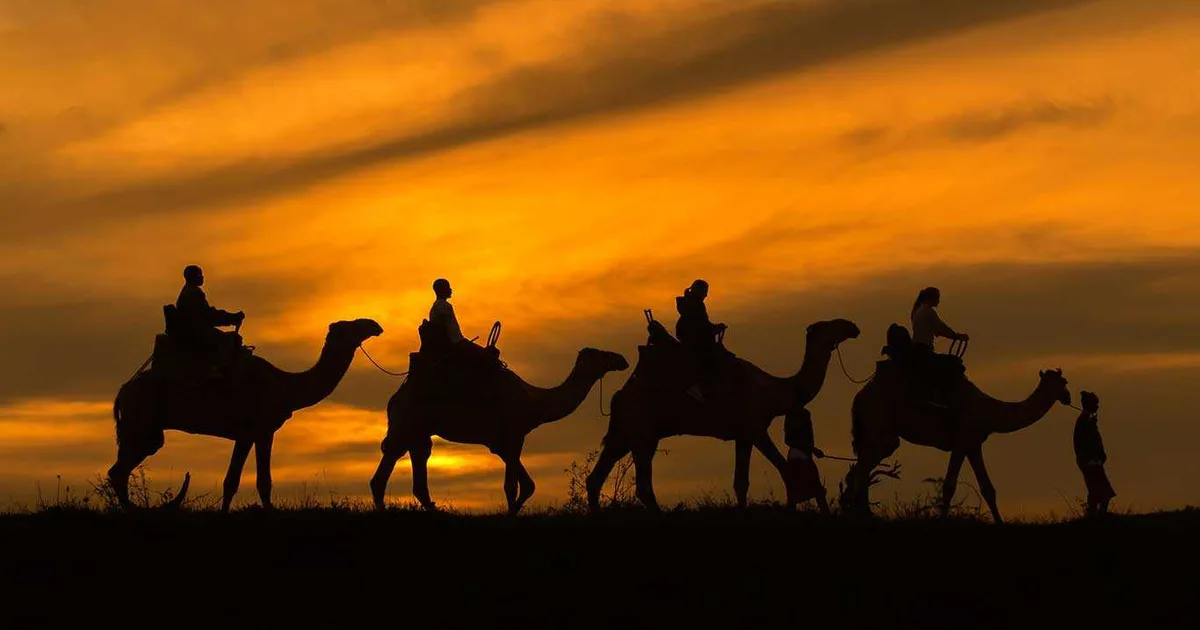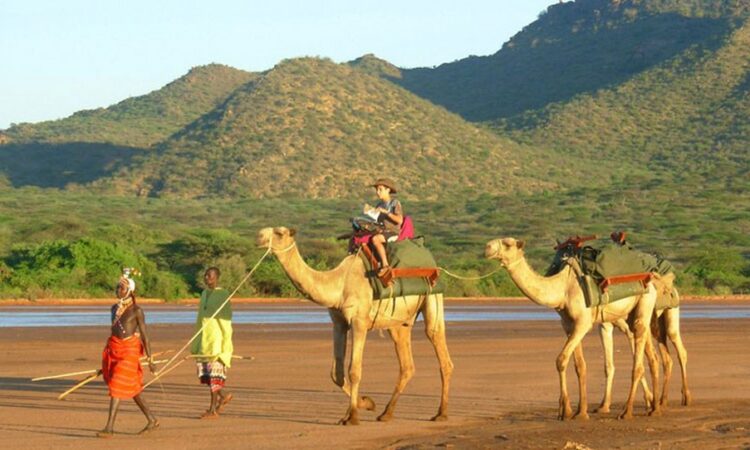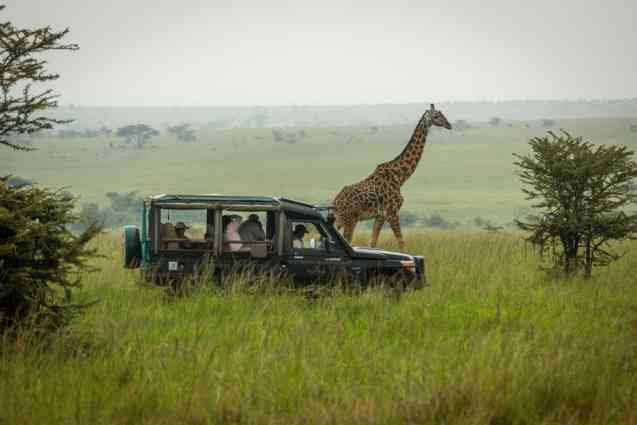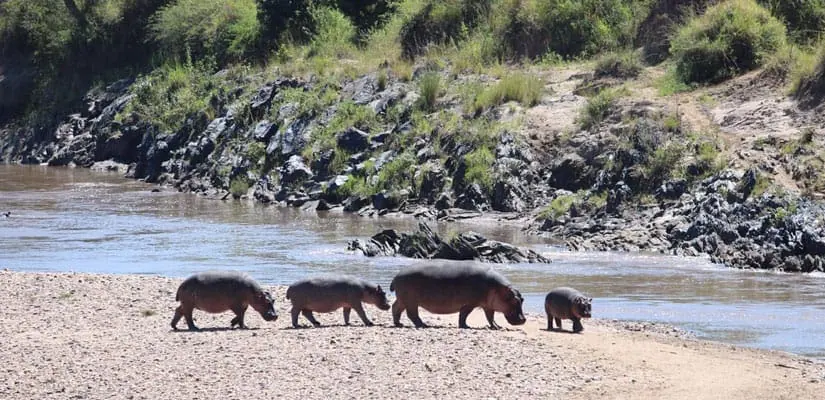- GET IN TOUCH WITH US:
- +256 753518160
- +256 777842166
- info@experiyatourcompany.com

What are the best hiking trails in Kenya?
November 19, 2025
Are there horseback safaris in Kenya?
November 19, 2025Can I Go Camel Trekking in Samburu?
Introduction: Discover Samburu on the Back of a Desert Ship
Samburu, located in the northern frontier of Kenya, is one of the country’s most enchanting and culturally rich destinations. Known for its rugged landscapes, the Ewaso Nyiro River, iconic wildlife species, and the proud Samburu people, this region offers an experience unlike anywhere else in East Africa.
But beyond the famous Samburu National Reserve and its abundant wildlife, one question many adventure travelers ask is: “Can I go camel trekking in Samburu?”
The answer is yes—absolutely. Camel trekking is one of Samburu’s most unique and rewarding activities. It is an ancient form of transport practiced for centuries by nomadic communities such as the Samburu, Rendille, and Turkana, and today, it has evolved into an unforgettable tourism experience.
Camel trekking in Samburu allows you to explore the semi-arid wilderness at a slow, immersive pace, guided by local warriors, and surrounded by landscapes that tell stories of tradition, survival, and natural beauty.
Why Camel Trekking Is Special in Samburu
Camel trekking is more than just an adventure—it is a cultural journey. Samburu camels are traditionally used by pastoralist tribes to transport goods, move cattle, and travel long distances across drylands. When you ride a camel in Samburu, you’re participating in a living tradition.
Reasons Camel Trekking Is Extraordinary
• deep cultural immersion with Samburu guides
• eco-friendly and quiet form of travel
• access to remote landscapes unreachable by vehicles
• perfect for photography and nature lovers
• peaceful, meditative pace
• connection to traditional nomadic life
Camel trekking allows you to slow down and truly absorb the wilderness.
Where to Go Camel Trekking in Samburu
1. Samburu National Reserve
Camel trekking is offered by some lodges and private operators around the edges of the reserve. The experience lets you explore acacia savannahs, dry riverbeds, and wildlife corridors.
What You Can Expect
• camels led by Samburu warriors
• sightings of Grevy’s zebra, giraffes, oryx, and antelopes
• views of rolling hills and open plains
• peaceful nature experience away from vehicle traffic
This is one of the best places to begin your camel trekking adventure.
2. Kalama Conservancy
Located adjacent to Samburu National Reserve, Kalama Conservancy is a community-owned conservation area known for its dramatic landscapes and strong Samburu cultural influence.
Why Trek in Kalama
• fewer crowds
• community-guided camel excursions
• stunning views of rocky outcrops and plains
• chances to see elephants, kudu, and reticulated giraffes
The conservancy provides a perfect balance of culture and wildlife.
3. Westgate Conservancy
Westgate is a key community conservancy offering authentic camel trekking led by Samburu guides.
Highlights
• scenic dry riverbeds
• camel caravans led by local warriors
• opportunities to visit Samburu homesteads (manyattas)
• sunrise and sunset treks
This location offers an immersive cultural and wilderness experience.
4. Namunyak Conservancy – Home of the Reteti Elephant Sanctuary
Namunyak Conservancy is one of the most beautiful landscapes in northern Kenya, stretching across mountains, valleys, and forests.
Why Camel Trekking Here Is Incredible
• pristine wilderness with almost no crowds
• dramatic mountain landscapes
• long-distance camel expeditions
• visits to village communities
• chance to combine trekking with Reteti Elephant Sanctuary tours
Namunyak is ideal for those seeking raw, untouched wilderness.
5. Matthews Range (Mathews Forest)
If you want to trek through lush forests, remote rivers, and mountains, camel trekking in the Matthews Range is unforgettable.
Unique Features
• trekking with Samburu guides and camel caravans
• walking or riding through cedar forests
• camping under star-filled skies
• pristine waterholes and wildlife sightings
• multi-day trekking experiences
This is one of Kenya’s most unique wilderness adventures.
6. Laikipia Plateau
Just south of Samburu, Laikipia is home to vast ranches and conservancies where camel trekking is a popular activity.
Why Choose Laikipia
• gentle terrain suitable for families
• long-distance camel treks with wildlife sightings
• panoramic scenery across rolling plains
• professional camel handlers
Laikipia’s camel safaris are perfect for both beginners and experienced adventurers.
Types of Camel Trekking Experiences in Samburu
1. Short Camel Rides (1–2 hours)
Ideal for families and travelers with limited time.
What to Expect
• brief scenic routes
• guided rides near camps or conservancies
• perfect for photography
• calm, easy introduction to camels
This is a good option for children or first-time riders.
2. Half-Day Camel Treks
These treks explore deeper into the wilderness and offer more interaction with Samburu guides.
Highlights
• wildlife viewing
• cultural storytelling
• tea or snack breaks in the bush
Great for adventure lovers who want a meaningful but manageable trek.
3. Full-Day Camel Treks
Longer journeys take you across open plains, riverbeds, and forested areas.
What Makes Full-Day Treks Special
• picnic lunches in scenic locations
• wildlife views in remote places
• deep immersion in Samburu cultural traditions
• peaceful, meditative pace
You ride part of the time and walk alongside the camels during other sections.
 4. Multi-Day Camel Safaris
4. Multi-Day Camel Safaris
The ultimate way to explore northern Kenya. Multi-day camel safaris are usually 2–7 days and involve camping in the bush.
Highlights of Multi-Day Camel Treks
• camping under star-filled skies
• camp set up by Samburu warriors
• storytelling around the fire
• walking and riding through stunning landscapes
• carrying gear on camel caravans
This experience is incredibly intimate and offers a true taste of nomadic life.
What You Will See During a Camel Trek
Camel trekking in Samburu offers outstanding opportunities to see:
• reticulated giraffes
• ostriches
• Grevy’s zebras
• kudu
• oryx
• elephants
• dik-diks
• colorful birdlife
The slow pace of the trek allows for close wildlife encounters without disturbing the animals.
Cultural Immersion with the Samburu People
Camel trekking is guided by Samburu warriors or morans who share their knowledge of:
• traditional customs
• animal tracking
• local plants and medicinal uses
• tribal folklore
• bush survival skills
• songs and storytelling
It’s one of the best ways to learn about Samburu culture.
What to Expect During the Trek
• camels equipped with saddles and carrying gear
• gentle, rhythmic motion while riding
• stops for water, photos, or wildlife viewing
• guidance from professional camel handlers
• optional walking sections for comfort
• light refreshments or meals depending on trek duration
Camel trekking is not physically demanding unless you choose long-distance treks.
Is Camel Trekking Safe in Samburu?
Yes, camel trekking is generally safe.
Operators prioritize:
• well-trained camels
• experienced handlers
• safe routes
• comfortable saddles
• controlled pace
Travelers of all ages can enjoy camel trekking.
Best Time to Go Camel Trekking in Samburu
The best seasons are:
• January to March
• July to October
These months offer warm temperatures, clear skies, and dry conditions.
Avoid April–June due to heavy rains in some areas.
What to Wear and Bring
• breathable long trousers
• lightweight shirt
• hat for sun protection
• sunglasses
• sunscreen
• comfortable walking shoes
• camera or phone
• reusable water bottle
In multi-day treks, operators provide camping gear, bedding, food, and support staff.
Why Camel Trekking Is a Must-Do in Samburu
• It’s a uniquely East African experience
• It combines culture, wildlife, and adventure
• It allows you to explore remote landscapes peacefully
• It’s eco-friendly and sustainable
• It supports local Samburu communities
Camel trekking is slow, intimate, and deeply immersive—perfect for travelers wanting something beyond the classic game drive.
Can I Go Camel Trekking in Samburu?
Yes—Samburu is one of the best places in Africa for camel trekking.
From the rocky outcrops of Kalama to the remote ranges of Namunyak and the cultural landscapes of Westgate, camel safaris offer an unforgettable journey through Kenya’s northern wilderness.
Whether you choose a short ride or a multi-day expedition, camel trekking allows you to explore Samburu the way nomadic communities have done for centuries—slowly, peacefully, and closely connected to the land.
It’s one of the most authentic, enriching, and memorable experiences you can have in Kenya.
For professionally organized camel trekking adventures in Samburu—with expert Samburu guides, safe routes, cultural immersion, and seamless logistics—book your journey with Experiya Tour Company. They ensure that every moment of your camel safari is meaningful, comfortable, and unforgettable.




